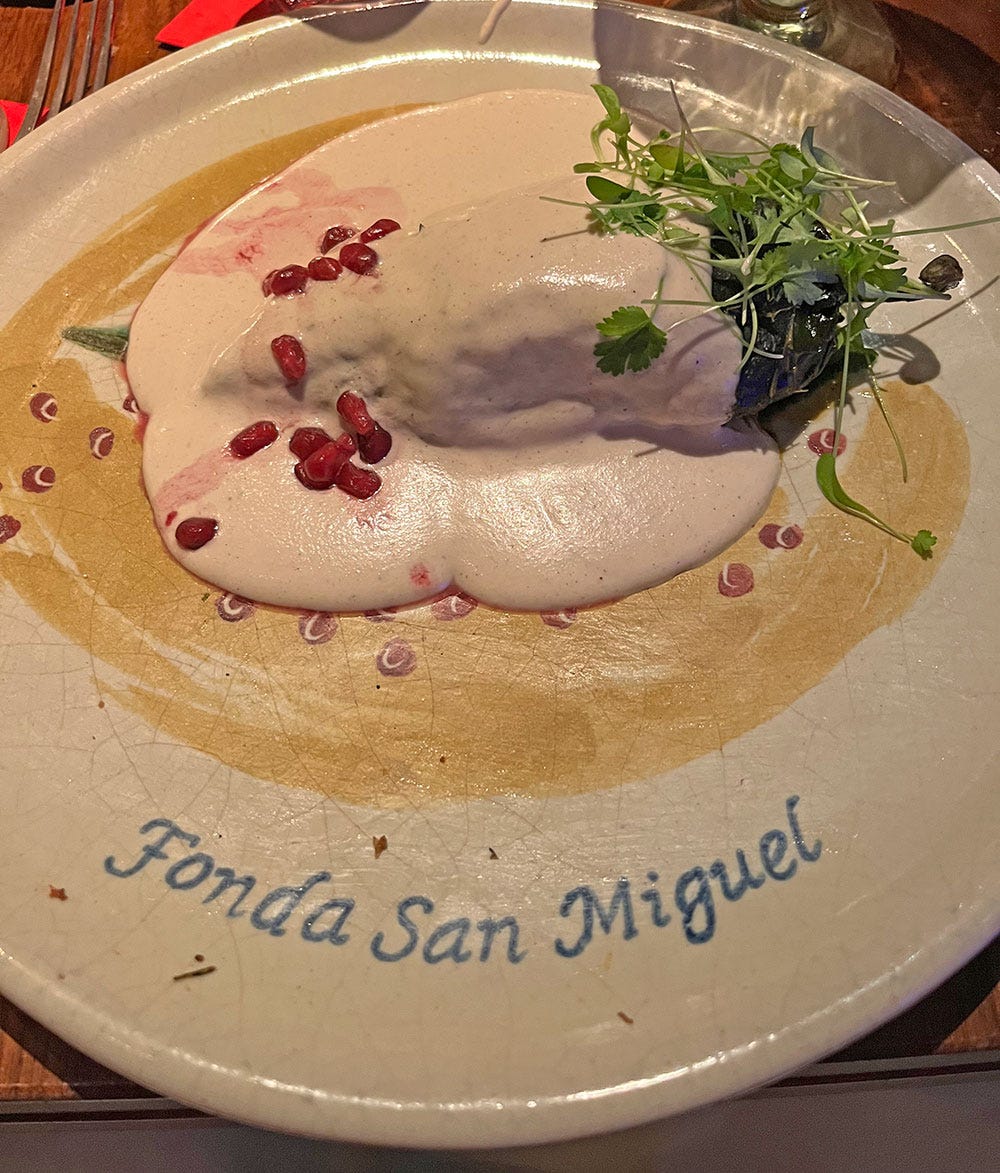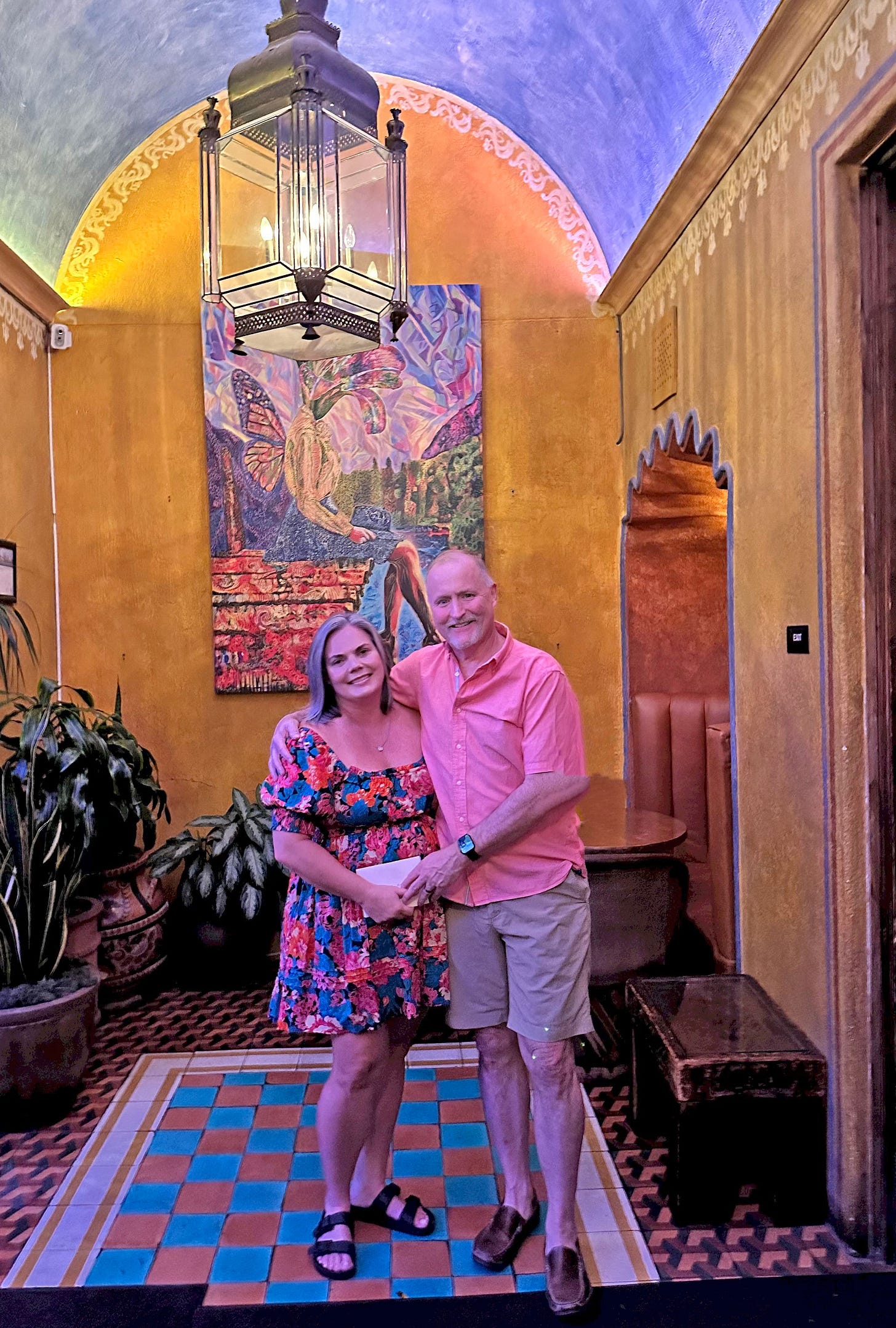Dealing with Fat Feelings and Eating the 'Right Way'
Plus, how to deal when you've quit diets, but your husband is still doing his thing.
Thanks for reading Almost Sated, a newsletter about diet culture detoxing for people who are always hungry for more. If you like what you’re reading, please consider subscribing and sharing! It’s free to join, and subscribing ensures you never miss a post.
Last night, Hubs and I enjoyed a romantic double date at one of the most storied restaurants in Austin’s history. Fonda San Miguel has been around since 1975, or as one of our dinner companions put it, “longer than I’ve been here,” which is how old Austinites (not necessarily natives, but those of us who’ve been around a few decades) measure old in Austin.
Pretty much anyone who’s been in Austin for any length of time remembers the first time they went to Fonda San Miguel. For me, it was college. Growing up in a blue-collar family, I hadn’t been to many “fancy” restaurants and sure couldn’t afford this one, but my dorm mate’s family was in town and had invited a bunch of us to go to brunch—and Grandma was paying. It was the most elaborate and exotic brunch I had ever experienced and the first time I had seen a “refined” woman of a certain age drinking beer from a bottle, at eleven in the morning no less.
Fonda San Miguel was the first restaurant in Texas to focus exclusively on authentic Mexican cuisine from Mexico’s interior culinary epicenters: Oaxaca, Puebla, Veracruz and Yucatan. And it still offers delicious dishes you won’t find at any of the other Tex-Mex joints in town. One of their specials last night was chiles en nogada, a seasonal dish typically only served in September to commemorate Mexico’s independence and when walnuts are in season. It features the colors of Mexico’s flag—a roasted green poblano covered in a rich white walnut sauce and topped with pomegranates.
I wore a colorful, off-the-shoulder number I picked up on clearance this summer, and to match, Hubs changed last-minute into a bright pink linen button down. As we’re pulling out of the drive, Hubs hits me with “I’ve got to lose some weight. None of my clothes fit.”
There’s a lot being conveyed in these two sentences. For those of us who have intentionally given up diets, these are almost fighting words. After a year of not dieting, it is triggering to hear them, but I also know when my husband says this, he’s talking about how he feels about himself. He’s not engaging in the mindless diet talk chatter that often comes up at holiday gatherings or when a group of middle-age white women who haven’t seen each other in a long time get together.
This is a man who has supported my decision to give up diets every step of the way, even when I’ve questioned whether I could keep doing it, and who tells me at least every other day how beautiful I am. He has never once said, “Can’t you just get off this anti-diet thing and get back to how things were?” But this is how he is. When I make a decision, he might question it, but then he supports me. But…also my decision might not be the one he makes for himself, which is where we are with diets. Somehow, we’ve navigated a full year of me not dieting and him occasionally talking about how fat he feels.
And to be clear, these are not conversations we bring up in front of my kids, two of whom are recovering from anorexia. It is absolutely not OK to engage in any kind of “fat talk” or body discussion, positive or negative, about yourself or anyone else in front of someone with an eating disorder. Since we often don’t know who is suffering from an eating disorder or disordered eating or body dysmorphia and these kinds of conversations can be triggering, they shouldn’t be happening casually.
“There’s a way to handle this,” I say, remembering I’ve written a post about how to handle your clothes not fitting that I haven’t yet published.
“There’s an easy answer and a right answer,” he shoots back. Then we look at each other and burst into laughter.
We’re laughing because we have wildly diverging views on this topic, and we’ve agreed to disagree. While I made the decision to quit diets a year ago, he’s still doing his thing. Luckily, we have enough mutual respect for each other that we can laugh at our differences. We are still in the honeymoon phase, but I hope this is how we always handle the things we can’t come to agreement on.
In case you’re wondering, his “easy answer” is to buy new clothes. I’m not sure most people, women especially, would agree this is the easy solution to gaining weight.
The “right answer” is the first reaction all of us lifelong dieters have when we discover we’ve put on weight: It’s to start the next diet.
For those of you wondering where this “right answer” came from, Anjali Prasertong, the Anti-Racist Dietitian here on Substack, wrote a Well + Good article this summer that talks about the dawn of modern nutrition during America’s Progressive Era (the 1890s to the 1920s) alongside eugenics, the now-discredited but then-accepted racist theory that humans could be improved through selective breeding. At a time when researchers were just beginning to understand what calories and vitamins were, Americans were being encouraged to eat the “right way”—not for pleasure but to better the population. Unsurprisingly, the right way was the “white way.” In other words, not the type of cuisine we enjoyed at dinner.
From her article:
“The science of modern nutrition was born deeply entwined with the ersatz science of eugenics, a tangle that mixed up morality with food choices, blending ‘eating white’ with ‘eating right.’ And as much as today’s nutrition community would like to distance ourselves from the harmful teachings and practices of this time period, many of the ideas about dietary choices and health born during this time are still alive and well.
Unfortunately, not so much has changed since the early 20th century with regard to mainstream society’s endless pursuit of the ‘ideal diet. When we create a model (or a plate) for ‘eating right’ that centers western eating habits, those whose cultural preferences don’t fit in that box are… ‘eating wrong’? You’d think we’d know by now that mixing morality into our food makes a bad dish.
Most of us don’t give any thought to where our feelings about the “right way” to eat come from, and just because we do learn later doesn’t mean we can let go of these feelings that have been so ingrained in us.
Those of us who have made the conscious decision to ditch diets still have those feelings from time to time, even when we mostly feel great otherwise. Dana Miranda and Steph Auteri both mentioned still struggling with body acceptance in their interviews for my new series Dared to Ditch about quitting diets (you can read their stories here and here). I still do, too. When I first started intuitive eating, I thought those feelings would magically disappear one day, and that’s when I would consider myself healed. Now, I’ve come to accept that because of my length of history with dieting, I may always have them from time to time. That’s not OK, but it is something I’ve come to accept. I wish we didn’t have to have these conversations. I wish no one struggled to accept their own body, but because I’ve dared to ditch diets, I’m much better at sitting with uncomfortable feelings.
Share Your Story of Ditching Diets
If you’ve found freedom from dieting, I’d love to share your story so that it may inspire someone else…or simply make them feel less alone. Comment below or reach out at at kristik @ substack.com.
Thanks for reading Almost Sated. Right now, I’m focused on getting this newsletter into the hands of people who need it. If you found what you read interesting, encouraging, or helpful, please make sure you’re subscribed and consider sharing it with others!







I would have to agree with you Kristi that the “easy answer” about sizing up is not an easy one for most women...
But it is most likely the “right” way because whether we like it or not, bodies change. And I’m definitely not always liking that they do 🥴
And I do agree and love the fact that we can agree to disagree and be respectful and loving.